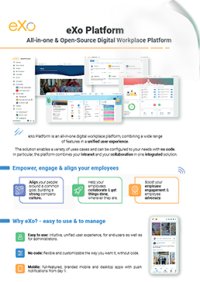


FREE WHITE PAPER
Discover, compare, and migrate to the best Workplace From Meta alternative
Over the past decade, organizations have profoundly transformed their work environments. Office employees now benefit from collaborative tools, digital workspaces, and instant communication solutions.
Meanwhile, a large part of the workforce — frontline employees — has been left out of this digital revolution.

Municipal agents, technicians, healthcare workers, production operators, or logistics staff… These employees, essential to service continuity and customer satisfaction, often lack access to their organization’s digital tools.
This paradox weakens cohesion, security, and overall efficiency. For IT departments, the challenge is significant: how to connect frontline workers without compromising on security or digital sovereignty?
The mobile-first digital workplace has emerged as a strategic answer — intuitive, inclusive, and secure, reconnecting the field with headquarters and placing every employee at the heart of digital transformation.
While most organizations have digitized office roles, frontline employees are often left behind in the digital transformation process.
According to a 2023 Deloitte study, only 23% of frontline workers believe they have access to the technology they need to be effective, and 80% report that their company offers few opportunities to connect to work.
These employees represent 80% of the global workforce, ensuring essential services — maintenance, healthcare, logistics, production, public services, and more.
The lack of access to digital tools fuels feelings of exclusion and isolation. A Yoobic report shows that 34% of frontline employees feel disconnected from headquarters, and 76% say they would feel more connected if they could access internal communication via mobile.
Without suitable tools, many bypass official IT systems — using WhatsApp groups, personal cloud drives, or unsecured public messaging apps.
This phenomenon, known as shadow IT, meets an immediate need for efficiency but creates major risks for security, compliance, and data governance.
For IT leaders, one fact is clear: digitizing the frontline is a prerequisite for performance, cohesion, security, and innovation.
For IT departments, digitizing frontline workers is not only about equipment and usability — it’s also about digital inclusion and risk management.
This means IT departments must:
🎯The goal: ensure equal access for all employees, allowing everyone to participate and engage in the organization’s life.
Extending IT systems to the field naturally increases risks — personal devices (BYOD), unsecured connections, and sharing of sensitive data.
IT departments must therefore prioritize:
Digital inclusion can only be sustainable if it relies on clear governance of identities, data, access, and infrastructure.
For public organizations and critical sectors (health, energy, local authorities), this aligns with a sovereignty approach — SecNumCloud hosting, access traceability, and vendor control.

Workplace Migration Guide : Comparaisons, Plans and Testimonials
Discover, compare, and migrate to the best Workplace From Meta alternative



Discover, compare, and migrate to the best Workplace From Meta alternative
The mobile-first approach, which makes mobile devices the central access point to an organization’s digital life, is a natural evolution of the workplace.
For many frontline employees, the smartphone is often their only available device.
A 2024 OpinionWay study found that 6 out of 10 French employees use their personal smartphone for work — a figure even higher among frontline workers, often without proper frameworks or security.
For IT departments, success relies on three pillars:
A mobile-first digital workplace also enhances cohesion between headquarters and the field.
Mobile tools help to:
Acting quickly is essential — 55% of frontline employees considered resigning in 2024, mainly due to lack of prospects, recognition, and access to the right tools, especially mobile ones.
Connecting frontline employees cannot come at any cost.
Field digitalization must rely on a secure, independent, sustainable, and sovereign technological foundation.
Ensuring sovereignty means:
This requirement is even more critical in the public sector, where frontline digitization often involves sensitive services — energy, hospitals, emergency services, critical infrastructure…
Open source now offers a reliable and sustainable alternative for building inclusive environments, thanks to its many advantages:
Open source provides a reliable and lasting path to digital autonomy.
The mobile digital workplace is now a strategic lever for including frontline employees, strengthening organizational cohesion, and improving overall performance.
However, transformation isn’t just about deploying apps on mobile devices — it’s about finding the right balance between inclusion, security, mobility, and sovereignty.
The IT department plays a central role: building a digital environment that connects frontline and office workers while maintaining control over data and systems.
Open source, mobile-first, responsible governance — the chosen approach must place user experience at the center.
For IT leaders, the challenge is to build an inclusive, adaptable, and sustainable digital workplace, one that supports collective performance and long-term trust.

eXo Platform : The Open-Source
Digital Workplace Platform
Download the eXo Platform Datasheet and discover all the features and benefits


Download the eXo Platform Datasheet and discover all the features and benefits
( Your e-mail address will not be published)
I am the communication manager at eXo Platform. I found myself in communications a bit by chance, but this field brings together everything that pationates me: creativity, energy, meetings, collaborative work, sharing and exchanges of good practices. I need to give meaning to what I do and put people at the center of all my actions.